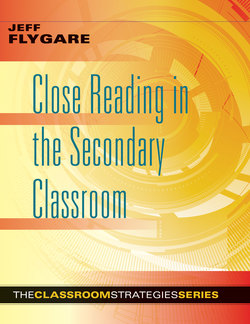Читать книгу Close Reading in the Secondary Classroom - Jeff Flygare - Страница 7
На сайте Литреса книга снята с продажи.
ОглавлениеCONTENTS
Reproducibles are in italics.
| ABOUT THE AUTHOR | |
| ABOUT MARZANO RESEARCH | |
| INTRODUCTION | |
| Definition of Close Reading | |
| How to Use This Book | |
| CHAPTER 1 | RESEARCH AND THEORYThe Need for Close ReadingThe History of Close ReadingResearch BackgroundInstructional ShiftsA Process for Close ReadingSummary |
| CHAPTER 2 | PREREADINGText SelectionTeacher PreparationStudent Introduction to Close ReadingPrereading ActivitiesSummaryChapter 2: Comprehension Questions |
| CHAPTER 3 | READING TWICE AND ANNOTATINGReading a PassageUsing Literary and Rhetorical Text DevicesSummaryChapter 3: Comprehension Questions |
| CHAPTER 4 | GENERATING QUESTIONS AND READING ANALYTICALLYStudent QuestionsAnalytical ReadingSummaryChapter 4: Comprehension Questions |
| CHAPTER 5 | DISCUSSING AS A CLASS OR ANALYZING INDIVIDUALLY, AND USING PROCESSING ACTIVITIESDiscussing as a Class or Analyzing IndividuallyUsing Processing ActivitiesSummaryChapter 5: Comprehension Questions |
| CHAPTER 6 | PLANNING AND ASSESSING CLOSE READINGMeasuring Student Progress in Close ReadingPlanning for Close ReadingAssessing Close ReadingSummaryChapter 6: Comprehension Questions |
| EPILOGUE | |
| APPENDIX A: ANSWERS TO COMPREHENSION QUESTIONSAnswers to Chapter 2: Comprehension QuestionsAnswers to Chapter 3: Comprehension QuestionsAnswers to Chapter 4: Comprehension QuestionsAnswers to Chapter 5: Comprehension QuestionsAnswers to Chapter 6: Comprehension Questions | |
| APPENDIX B: EXTENDED EXAMPLES OF CLOSE READINGLiterary Example 1Literary Example 2Informational Example | |
| REFERENCES AND RESOURCES | |
| INDEX |
